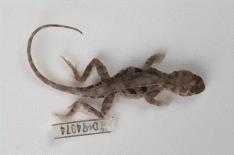
Ctenophorus is a genus of lizards, commonly known as comb-bearing dragons, in the family Agamidae. The genus contains the most diverse group of dragon lizards in Australia. It is the largest group of Australian lizards and it has an extensive radiation in the arid zones. Many of the species of Ctenophorus have been grouped by a similar morphology. The informal names and groupings within this genus — rock dragon, crevice-dragon, ground-dragon, sand-dragon, and bicycle-dragon — are named after the mythological creature, the dragon.

Tympanocryptis tetraporophora, also known as Eyrean earless dragon or long-tailed earless dragon, is one of a documented species of a relatively small dragon belonging to the genus Tympanocryptis. Tympanocryptis is differentiated from other genera within the family Agamidae by a tympanum covered with scales and a missing phalange in the fifth toe of the rear foot. T. tetraporophora is a ground dwelling dragon inhabiting semi arid regions of central New South Wales, arid regions of South Australia, Northern Territory, Queensland and tropical grasslands of Northern Queensland.
Tympanocryptis centralis, also known as central Australian earless dragon or central pebble dragon, is one of a documented species of a relatively small dragon belonging to the genus Tympanocryptis.

Tympanocryptis pinguicolla, also known as Victorian grassland earless dragon, is a critically endangered species of lizard in the family Agamidae. It is one of a documented species of a relatively small dragon belonging to the genus Tympanocryptis.

Tympanocryptis pentalineata, also known as five-lined earless dragon, is one of a documented species of a relatively small dragon belonging to the genus Tympanocryptis.
The gibber earless dragon also known as the smooth-snouted earless dragon, is a species of agamid lizard endemic to Australia. It is one of a documented species of the genus Tympanocryptis, a group of small terrestrial lizards that feed off invertebrates and are characterised by the absence of an external ear structure.
Tympanocryptis argillosa, the claypan earless dragon, is a species of agama found in Australia.
Tympanocryptis cephalus, the blotch-tailed earless dragon or coastal pebble-mimic dragon, is a species of agama found in Australia.
Tympanocryptis diabolicus, the Hamersley pebble-mimic dragon, is a species of agama found in Western Australia.
Tympanocryptis fictilis, the harlequin earless dragon, is a species of agama found in Australia.
Tympanocryptis gigas, the Gascoyne pebble-mimic dragon, is a species of agama found in Australia.
Tympanocryptis lineata, the Canberra grassland earless dragon or lined earless dragon, is a species of agama found in Australia.
Tympanocryptis macra, the savannah earless dragon, is a species of agama found in northernWestern Australia and the Northern Territory. It was described originally as Tympanocryptis lineatamacra in 1982 by Glen Milton Storr.
Tympanocryptis mccartneyi, the Bathurst grassland earless dragon, is a species of agama found in Australia.
Tympanocryptis osbornei, the Monaro grassland earless dragon, is a species of agama found in Australia.
Tympanocryptis petersi, the lined earless dragon, is a species of agama found in South Australia. The specific epithet, petersi, honours Wilhelm Carl Hartwig Peters, who described the genus and type species, Tympanocryptis lineata.
Tympanocryptis pseudopsephos, the Goldfields pebble-mimic dragon, is a species of agama found in the Goldfields region of Western Australia.
Tympanocryptis rustica, the Tennant Creek pebble dragon, is a species of agama found in the Northern Territory of Australia.
Tympanocryptis tolleyi, the Gawler earless dragon, is a species of agama found in South Australia.

Tympanocryptis wilsoni, the Roma earless dragon, is a species of agama found in Queensland, Australia.





